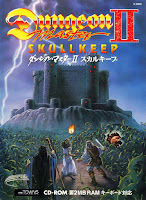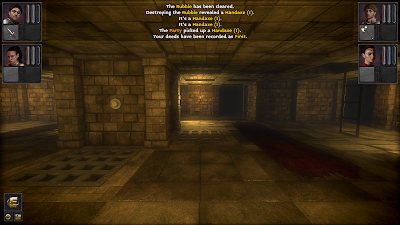When I am lucky I stumble across indie RPGs that I have never heard of that turns out to be real gems. A few weeks ago when browsed around I found a game called The Quest that was available at Steam for $9.99. The reviews was very positive and by looking at the screenshots I was hooked directly. After reading a little about the game I decided to buy it and have now been playing it for over 38 hours.
Have they succeeded ? Yes! For its maegre money they deliver a game with CRPG elements that we all have learned to love. A large non-linear gameworld filled with plains, woods, mountains, seas and underground places. The game is filled with a lot of different monsters and adversaries. Skills and attributes to improve when levelling, lots of items, automap, questlog etc.
You play yourself, an agent sent out by the king to find out what has happened to a local governor that mysteriously has disappeared from an island. When you start you will have to find information about the governor and there are a lot of rumours going around. You soon find out you have to reach certain places far away from where you start and in order to do so you will have to be well-trained and ready. This means you have to take on sidequests to earn money to be able to afford better weapons and armours and gaining experience points by slaying monsters so you can upgrade your skills. Eventually you will be able to travel farther and farther away from your starting town and begin to explore the vast lands. The game is large. The island is built up of up to 100 areas, all which have their own names and are of the same sizes. I haven´t counted them but they are at least 40x40 hexes each which means the game world is built up of over 100.000 squares. Yes you move in a tile-based movement so no free roaming here and no jumping.
You begin the game by creating your character out of a few races and then choose a profession. The profession includes a subset of all the skills for which you will only pay one skill point to increase. All other skills will cost 2 skill points per level. You could also opt to create your own character fully, which I choosed. There are around 20 skills and some attributes on which they are based like strength, endurance, dexterity, personality, intelligence etc. I choosed a battlemage but changed some of the preselected skills.
You have different starting positions in the game world depending on your choosen profession but I suspect all end up in around the same area. But it is a nice touch. I for example, started out in an underground cave and had to fight bats and rats while slashing some cobwebs that blocked my way.
After getting out and equipped myself with the very few items I started with, like a dagger I managed to find a village not far from the cave. In the village I heard my first rumours about the governor and the sickness and also a little history.
I spent the first few hours trying to get some experience by doing some small sidequests around the area, gathering all loot I could find and sold it in the town in order to upgrade my weapons and armour. Most of my money was spent for food which is needed to rest and heal. You move around the overland in a tile-based movement in realtime but when an enemy come close enough it switch to a turn-based combat. All fights are to the death and you cannot run away. Not even if you lure the enemies back to town will any guard step in and help you. This means you should be careful in which fights you get into.
During combat you could drink a potion, cast a spell, read a scroll, move or attack your opponent. Combat is quite static but will require you to use some tactics especially for tougher opponents. A maximum of two opponents could confront you on each side which means you sometimes have to navigate to places where you will fight as few as possible at once.
Combat is quick which compensates the lack of tactical finesse. You get experience points almost only for killing enemies and few - if any - for solving quests which is a bit disappointing. The environment and graphics of the game is quite good. It is clear and functional. You have a few environemental effects like rain or thunders, night and day which affect things like ability to rest or opening hours in the towns.
The game is really fun and captures the feeling of trying to reach the next level in order to receive the attribute points and skill points to spend. You also get some "free" upgrades of the two most used skills since last levelling which is a nice feature.
There are quite many items in the world and weapons and armours are divided into light and heavy stuff which requires its corresponding skill. The advantage of the heavy stuff is that they do the best damage and protects the most but at the cost of being so heavy you hardly have room for other inventory stuff. On the other hand you would surely focus as a fighter then and have to put points into strength which increase your carrying capacity.
As a battlemage I had light armours and weapons and relied mostly of magic in the first hand. I had to spend a fortune on healing and mana potions which meant I had to pick up everything I could find to sell for money. Especially in the later part of the game when you need dozens of full mana potions just in order to take on a few tough enemies.
Magic is divied into magical schools, each with its corresponding skill. Each group have half a dozen spells or more which you need to buy, or find in books to scribe in order to use. You could also find a lot of scrolls and wands in the game. The more skill points invested into a magical school the better the effect wether it is direct damage, healing effects or enchantment capabilities.
Yes, you could enchant items and add a lot of different abilites to them like increasing attribute points or fortifying skills. Actually, I first felt powerful in the latter half of the game when I first started to enchant my items and gave every singe item a fortify armour value which made me into a tank. I could then stand there in melee combat and cast spells at my enemy.
There are a few very good and powerful items scattered around in the world which you get from quests but you could also find good items in the market. Each town has a different set of stock which replenishes after a few days.
This game reminds me a bit of the Might and Magic series and if you remember you had spells like town portal, mark and recall. Yupp! They are all here as well. Very convenient and powerful.
It took me over 20 hours to even start on the main quest in the game. It wasn´t obvious for me in the beginning what I should do but it became clearer when I went to the east part of the island. Then I begun to focus on following the mainquest and finally brought it to an end. The game is quite tough. It will reward patience and you have to avoid certain dangers and come back later when you got better. I love such systems.
 |
| A little puzzle where you have to shoot the lever to activate it |
Even tough I felt quite powerful in the end I never felt I was invincible in any way. Even wandering creatures on the east side of the island always pestered me and drained my supply of mana or degraded my equipment. Yupp, you have repair skills and your weapons and armours could eventually become broken and gradually decrease the combat or armour value on the way.
You always have access to a pretty good automap in which you could make notes and a quest diary which lists all active quests. There are no helper arrows or markers though so you have to remember what is being said and use the short quest description.
There are a lot of sidequests in the game and I think most of them are pretty good. The dialogues are quite good and you are given several options to answer. It is not as advanced as in the Baldurs Gate but better than what is expected for these kind of games.
Most of the skills in the game are very useful but others can be managed without by using scrolls. For example lockpick and disarm. I never found out the use of stealth or persuasion. I think those skills are pretty weak. The spell (or if you prefer to buy it in the town) Enchant is very powerful and was a must for me to keep up with the tough opposition.




In the end I liked this game very much. It loads extremely quick and is very accessible to play. It just about the right size and rewards a carefully character build. Since I am always a careful person I save up many skill and attribute points until I really need to spend them which meant I had a few points left when completing the game at level 15. There were some really tough fights - particularly in the end of the game. I won´t spoil anything to mention them but my advice is to use the environment to your advantage and try to lure enemies to come to you through small passageways. Especially if you are outnumbered. It also required some thinking with different strategies in order to beat certain opponents. I had to use both wands and potions in huge amounts in order to win. Things are not getting easier than opponents that could inflict diseases on you which renders you almost helpless. Fortunately there is a full alchemy part of the game where you can find ingredients everywhere and brew your own potions by trial and error or by reading books. Very helpful to get rid of warrt or plague for example.
 |
| This was my ending character sheet |
 |
| I had a lot of unused skill points in reserve |
The game is fully recommended:
Section
|
Rating
|
Gameworld & Story
|
2
|
Economy
|
3
|
NPC & Interactions
|
2.5
|
Monsters, tactics & combat system
|
3
|
Magic system
|
2
|
Character generation & development
|
3
|
Map design
|
3
|
Manual
|
3
|
Graphics, Sound and Interface
|
3
|
Summary CRPG value
|
24.5
|
|
|
Gameplay
|
4
|


















































